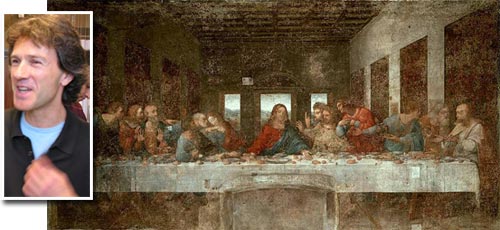 Science Wednesday: OnAir - Cracking The Da Vinci Color Code
Science Wednesday: OnAir - Cracking The Da Vinci Color Code
Posted on December 30th, 2009 - 10:30 AM
Constaninos Sioutas, Ph.D. typically conducts air pollution research on polluted highway roadsides or near running diesel engines. But a recent project lured him to a much more refined location-- face to face with Leonardo da Vinci's, The Last Supper.
Sioutas is a co-director of the Southern California Particle Center , a consortium of universities researching air pollution. The Center is funded by a multimillion-dollar EPA grant. Sioutas' current research focuses on exposure to mobile air pollution sources and their potential toxicity, begging the question--what in the world does he have to do with da Vinci?
I got the chance to ask him in person when I traveled to his laboratory in October. As it turns out, over years of conducting air pollution research through EPA grants, Sioutas developed several new scientific instruments for capturing air particles and measuring their properties. One of these instruments, a Personal Cascade Impactor Sampler separates airborne particles by size and allows for analysis of the particles' toxic content.
After developing this new technology, Sioutas started to think outside the box. What if this instrument could be used to understand how exposure to air and particle settling would affect the color longevity of a painting such as, say, The Last Supper?

Sioutas traveled to Milan to present a research proposal to The Last Supper's curator, Dr. Alberto Artioli, asking just that question. He proposed to use his Impactor to take a series of measurements both inside and outside the legendary Refettorio, where the mural is on display.
Dr. Artioli was "positively impressed" and accepted Sioutas' proposal. One goal of the project will be to determine the sources of particles settling on the painting, down to such diminutive possibilities as erosion from visitors' shoes and clothing fibers, in addition to outdoor sources like traffic exhaust.
"It is really an amazing experience," Sioutas said, beaming, "getting to apply these instruments for such a different task." According to the project proposal, the study will draw conclusions about "the degradation risks to the Leonardo da Vinci's painting."
Read more about this EPA-funded research, by using this link: Personal Cascade Impactor Sampler
About the Author: Becky Fried is a student contractor with EPA's National Center for Environmental Research, part of the Office of Research and Development. Her "OnAir" Science Wednesday posts chronicle EPA-funded research on clean air.
